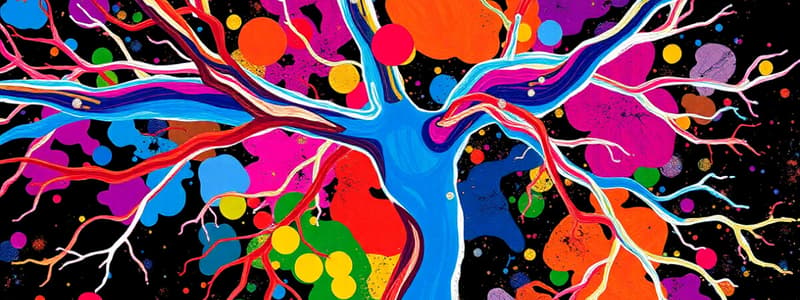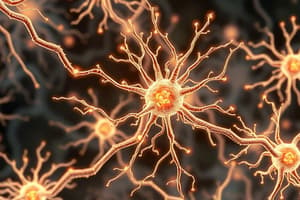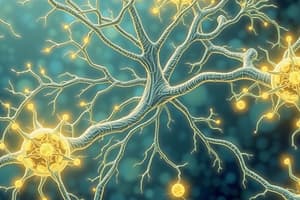Podcast
Questions and Answers
Which of the following functions is not associated with the parasympathetic branch of the autonomic nervous system?
Which of the following functions is not associated with the parasympathetic branch of the autonomic nervous system?
- Decreased blood pressure
- Increased mucous production
- Increased heart rate (correct)
- Bronchoconstriction
What type of neuron is responsible for transmitting signals from the brain and spinal cord to muscles?
What type of neuron is responsible for transmitting signals from the brain and spinal cord to muscles?
- Sympathetic neurons
- Sensory neurons
- Somatic (motor) neurons (correct)
- Parasympathetic neurons
Which of the following neurotransmitters is primarily utilized by somatic motor neurons?
Which of the following neurotransmitters is primarily utilized by somatic motor neurons?
- Serotonin
- Dopamine
- Norepinephrine
- Acetylcholine (correct)
What is the function of sensory neurons in the peripheral nervous system?
What is the function of sensory neurons in the peripheral nervous system?
Which of the following branches of the nervous system is responsible for the 'fight-or-flight' response?
Which of the following branches of the nervous system is responsible for the 'fight-or-flight' response?
Which of the following drug classes would have the effect of decreasing heart rate?
Which of the following drug classes would have the effect of decreasing heart rate?
What is the primary neurotransmitter at the neuroeffector site of the sympathetic nervous system?
What is the primary neurotransmitter at the neuroeffector site of the sympathetic nervous system?
Which of the following adrenergic receptor subtypes is primarily responsible for bronchodilation?
Which of the following adrenergic receptor subtypes is primarily responsible for bronchodilation?
What is the main difference between parasympathomimetics and cholinergics?
What is the main difference between parasympathomimetics and cholinergics?
A drug that blocks the action of norepinephrine at its receptor site would be classified as:
A drug that blocks the action of norepinephrine at its receptor site would be classified as:
Flashcards
Parasympathomimetic
Parasympathomimetic
An agent that stimulates the parasympathetic nervous system.
Parasympatholytic
Parasympatholytic
An agent that blocks or inhibits the effects of the parasympathetic nervous system.
Sympathomimetic
Sympathomimetic
An agent causing stimulation of the sympathetic nervous system, enhancing 'fight or flight'.
Adrenergic
Adrenergic
Signup and view all the flashcards
Anticholinergic
Anticholinergic
Signup and view all the flashcards
Central Nervous System (CNS)
Central Nervous System (CNS)
Signup and view all the flashcards
Peripheral Nervous System (PNS)
Peripheral Nervous System (PNS)
Signup and view all the flashcards
Sensory Neurons
Sensory Neurons
Signup and view all the flashcards
Somatic (Motor) Neurons
Somatic (Motor) Neurons
Signup and view all the flashcards
Parasympathetic Branch
Parasympathetic Branch
Signup and view all the flashcards
Study Notes
Central and Peripheral Nervous Systems
- Central Nervous System (CNS) encompasses the brain and spinal cord, controlling voluntary and involuntary actions.
- Peripheral Nervous System (PNS) lies outside the CNS, including sensory, sympathetic, and parasympathetic nerves.
Sensory Neurons (Afferent)
- Sensory neurons transmit signals from the body's periphery to the brain and spinal cord for processing.
- These signals allow the body to respond appropriately to stimuli.
Somatic (Motor) Neurons (Efferent)
- Somatic motor neurons relay signals from the brain and spinal cord.
- Acetylcholine acts as the primary neurotransmitter in this system.
Autonomic Nervous System
- The autonomic nervous system comprises the sympathetic and parasympathetic branches, controlling automatic functions.
Parasympathetic Branch (Rest and Digest)
- Cardiopulmonary Effects: Lowers heart rate, blood pressure, and respiratory rate; causes bronchoconstriction and increased mucus production.
- Neurotransmitter: Acetylcholine (ACh) functions at both ganglionic synapses and neuroeffector sites.
- Parasympathomimetic: Agents stimulating the parasympathetic system.
- Parasympatholytic: Agents inhibiting the parasympathetic system.
- Cholinergic: Drugs stimulating ACh receptors.
- Anticholinergic: Drugs blocking ACh receptors, causing effects opposite to parasympathetic stimulation.
- Muscarinic: Cholinergic receptors at parasympathetic end sites.
Sympathetic Branch (Fight or Flight)
- Cardiopulmonary Effects: Increases heart rate, blood pressure, and respiratory rate; causes bronchodilation.
- Neurotransmitters: ACh at ganglionic synapses and norepinephrine (NE) at neuroeffector sites.
- Sympathomimetic: Agents stimulating the sympathetic system.
- Sympatholytic: Agents inhibiting the sympathetic system.
- Adrenergic: Drugs stimulating norepinephrine or epinephrine receptors.
- Antiadrenergic: Drugs blocking norepinephrine or epinephrine receptors.
- Adrenergic Receptor Types:
- Alpha 1: Peripheral blood vessels
- Alpha 2: Central nervous system
- Beta 1: Heart
- Beta 2: Bronchial smooth muscle (bronchodilation), cardiac muscle
- Beta 3: Lipocytes (fat cells)
Studying That Suits You
Use AI to generate personalized quizzes and flashcards to suit your learning preferences.




